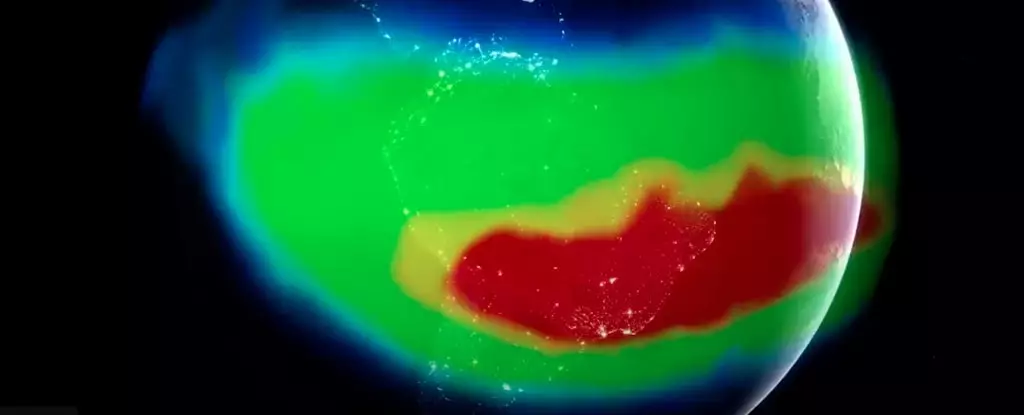Among the many wonders of Earth’s natural systems, the South Atlantic Anomaly (SAA) stands out as a peculiar enigma that has drawn the scrutiny of scientists for years. This region, characterized by an unsettling dip in the Earth’s magnetic field, arcs between South America and southwest Africa, giving rise to a host of questions concerning its origin, behavior, and impact on our planet and beyond. As a unique area in Earth’s magnetosphere, the SAA creates conditions that could have profound implications, especially for spacecraft operating in low-Earth orbit, like NASA’s satellites and the International Space Station.
Understanding the SAA begins with recognizing the interplay of forces that shape Earth’s magnetic field. This field is primarily created by the movement of molten iron within the outer core, generating electrical currents that manifest as magnetism. Yet, this is not a straightforward phenomenon; numerous factors, including geological formations deep beneath the Earth’s crust, contribute to localized variations in magnetic intensity. The SAA represents one of these variations, where effectively, a ‘pothole’ in space exists, leading to reduced magnetic protection against solar radiation.
The Implications for Spacecraft
The implications of the SAA extend well beyond theoretical curiosity. For operators of satellites traversing through this weakened area, the risks are very real. Charged particles from the Sun can penetrate these gaps in magnetic shielding, resulting in disruptions or failures in satellite systems. While many of these events may cause minor glitches, the potential for critical component damage is a constant threat. Consequently, satellite operators are necessitated to implement precautionary measures, such as temporarily shutting down sensitive systems, before they pass through this magnetic caveat.
NASA has been at the forefront of monitoring the SAA due to these operational risks. Their research has identified that this anomaly does not significantly impact terrestrial life directly; however, its influence on orbital technology underlines the urgency to study this and similar phenomena. In this respect, the anomaly is a twin-edged sword; while it poses dangers to space missions, it also serves as a fertile ground for scientific inquiry.
Delving deeper into the geological underpinnings of the SAA uncovers a range of sources contributing to its formation. It is believed that the dynamics of core convection—driven by temperature variances and density differences in the outer core—play a crucial role in the creation of magnetic anomalies. Additionally, formations like the African Large Low Shear Velocity Province, lying nearly 3,000 kilometers beneath the surface, weaves into this tale. This dense geological mass alters the magnetic field generation process, further enhancing the SAA’s uniqueness.
In recent analyses, researchers noted the SAA has been in a state of gradual transformation. Most compelling is the indication that it might be dividing—a phenomenon observed in studies confirming that two distinct cells of low magnetic intensity are emerging. This observation suggests that the SAA is not a static phenomenon but rather a dynamic element of Earth’s magnetism, thus inviting even more profound scrutiny into its causes and consequences.
A Historical Perspective on Magnetic Changes
Interestingly, the historical aspect of the SAA hints at a much longer timeline of magnetic behavior than previously assumed. Emerging studies indicate that the SAA might not be merely a contemporary aberration but rather a repetitive feature that has been a part of Earth’s magnetic landscape for millions of years. Some researchers posit that this anomaly could have been exhibiting similar patterns as far back as 11 million years ago.
Exploring these historical changes raises intriguing questions about the Earth’s magnetic field dynamics and its long-term behavior. The notion that the SAA is not a precursor to a full magnetic field reversal—which occurs every several hundred thousand years—provides a critical distinction in understanding how Earth’s magnetic system operates, keeping a variety of scientific perspectives in play.
As the study of the South Atlantic Anomaly advances, several critical inquiries remain. What does the division of the SAA mean for Earth’s magnetic future? How is this anomaly likely to evolve, and what could its implications be for technology? Researchers like Terry Sabaka emphasize the importance of continuous monitoring and exploration to unravel these mysteries, suggesting that ongoing missions dedicated to this unique phenomenon will contribute significantly to our understanding of geomagnetic behavior.
The South Atlantic Anomaly, while initially a perplexing concern for satellite operators, unfolds into a broader narrative that encompasses geological, environmental, and technological domains. As we stand on the cusp of further discoveries, it is clear that this magnetic puzzle warrants our keen attention, holding secrets that could reshape our comprehension of Earth’s magnetic field and its many intricacies.


Leave a Reply